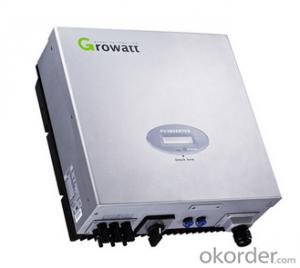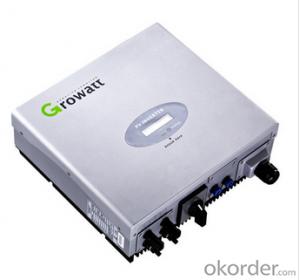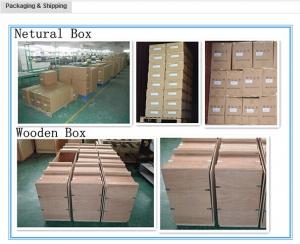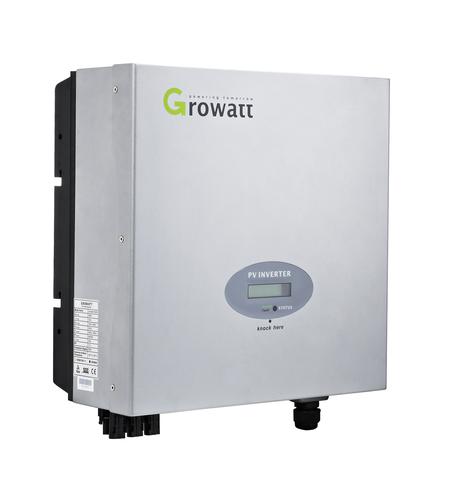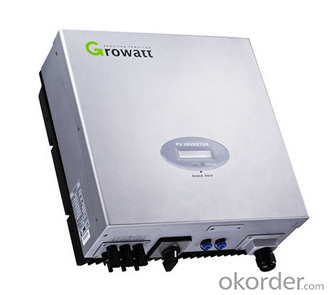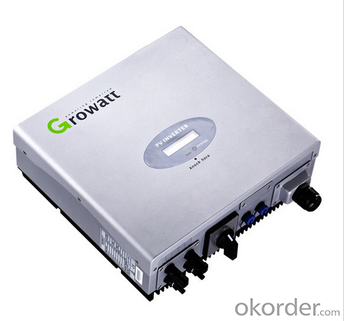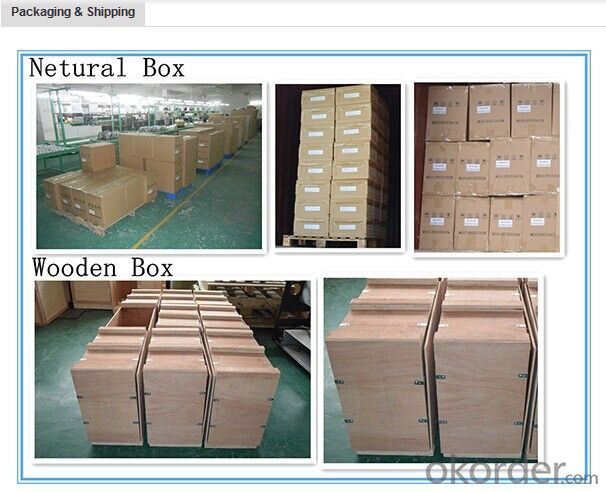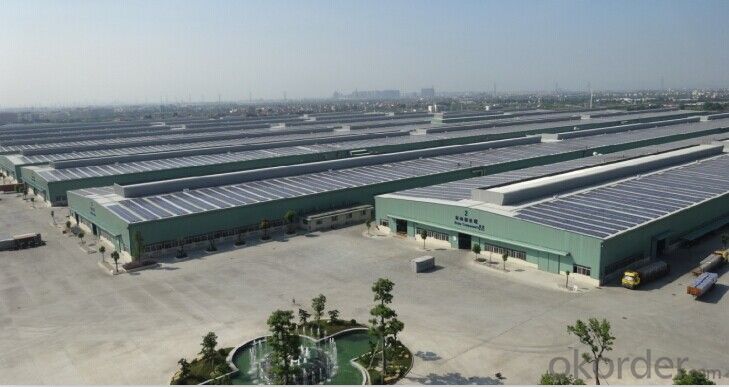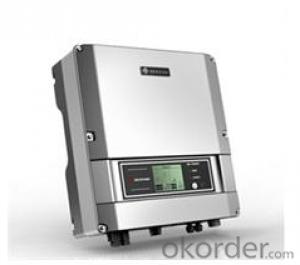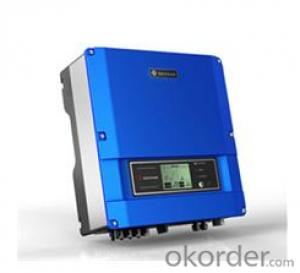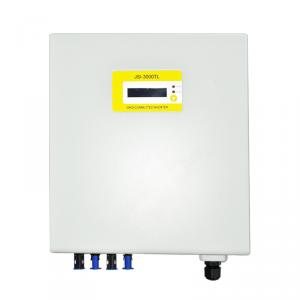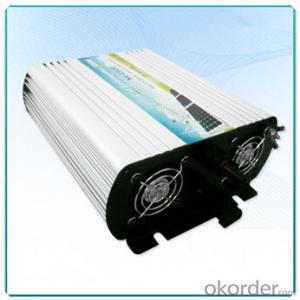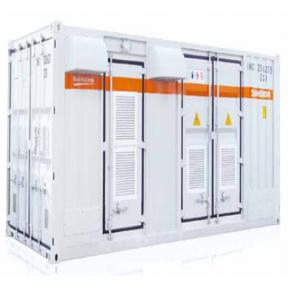Best Rv Solar Inverter 4000W-5000W Grid Connected Solar System
- Loading Port:
- Shekou
- Payment Terms:
- TT or LC
- Min Order Qty:
- 10 pc
- Supply Capability:
- 10000 pc/month
OKorder Service Pledge
OKorder Financial Service
You Might Also Like
Grid Connected Solar inverter 4000W-5000W
Maximum efficiency of 97.8% and wide input voltage range
Internal DC Switch
Transformerless GT topology
Compact design
MTL-String
Bluetooth/ RF technology/ Zigbee/ Wi-Fi
Sound control
Easy installation
Comprehensive Growatt warranty program
Maximum efficiency of 97.8%
wide input voltage range
Internal DC Switch
Transformerless GT topology
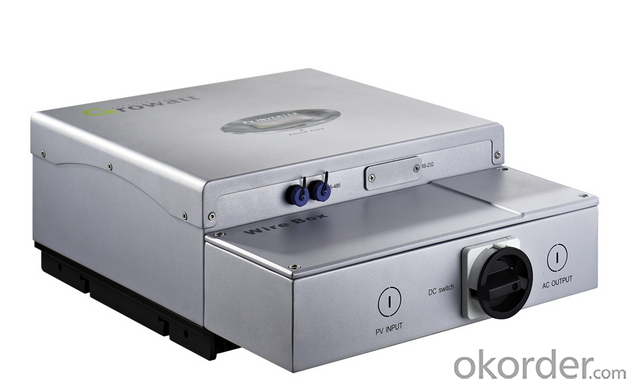
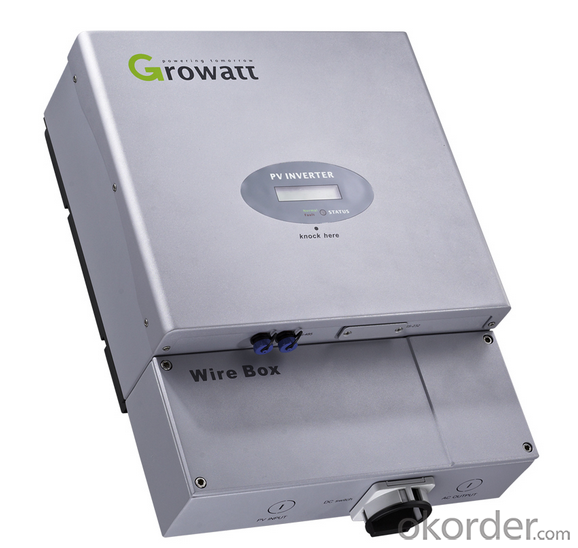
Communications
> RS485 /GPRS interfaces
> Computer monitoring software
Safety
> Full protection functions:DC reverse polarity, AC short-circuit protection, ground fault monitoring, grid monitoring, integrate all-pole sensitive, leakage current monitoring unit.
> Standards complied: EN61000-6-1, EN61000-6-2, EN61000-6-3, EN61000-6-4,EN61000-3-2, EN50178, VDE0126-1-1,IEC-62109
Technical Specifications
4000TL | 4400TL | 5000TL | |
| Inputdata | |||
| Max.DCpower | 4600W | 5000W | 5800W |
| Max. DC voltage | 580V | 580V | 580V |
| StartVoltage | 120V | 120V | 120V |
| PV voltage range | 90V-580V | 90V-580V | 90V-580V |
| MPP voltage range/ Nominal voltage | 95V-580V/360V | 95V-580V/360V | 95V-580V/360V |
| Full load DC voltage range | 250V-500V | 250V-500V | 250V-500V |
| Max. input current/ per string | 20A/20A | 20A/20A | 20A/20A |
| Number of independent MPP trackers /strings per MPP tracker | 1/3 | 1/3 | 1/3 |
| Efficiency | |||
Max.efficiency | 97.8% | 97.8% | 97.8% |
| Rated AC output power | 3680W | 4200W | 4600W |
| Max. AC power | 4000W | 4400W | 5000W |
| Max. output current | 16A | 21A | 25A |
| AC nominal voltage; range | 220V/230V/240V 180Vac-280Vac | 220V/230V/240V 180Vac-280Vac | 220V/230V/240V 180Vac-280Vac |
| AC grid frequency; range | 50Hz, 60Hz;±5Hz | 50Hz, 60Hz;±5Hz | 50Hz, 60Hz;±5Hz |
| Power factor | 1 | 1 | 1 |
| THDI | <3% | <3% | <3% |
| AC connection | Single phase | Single phase | Single phase |
| Protection Devices | |||
| DC reverse polarity protection | yes | yes | yes |
| DC switch rating for each MPPT | yes | yes | yes |
| Output over current protection | yes | yes | yes |
| Output over voltage protection-varistor | yes | yes | yes |
| Ground fault monitoring | yes | yes | yes |
| Grid monitoring | yes | yes | yes |
| Integrated all-pole sensitive leakage current monitoring unit | yes | yes | yes |
| Generaldata | |||
Dimensions(W/H/D) in mm | 406/406/192 100% | 406/406/192 21KG | 406/406/192 |
| Features | |||
DC connection AC connection Display Warranty: 5years/10years | H4/MC4(opt) Screw terminal LCD yes/opt | H4/MC4(opt) Screw terminal LCD yes / yes / yes/opt | H4/MC4(opt) Screw terminal LCD yes / yes / yes/opt |
| Certificates and ApprovalsCE, VDE 0126-1-1, DK5940, G83, G59, RD1663, EN50438, IEC 62109, ENEL-Guide |
- Q: Can a solar inverter be used with different types of solar panels?
- Yes, a solar inverter can be used with different types of solar panels as long as the voltage and current specifications of the panels are compatible with the inverter.
- Q: How does a solar inverter handle frequency variations in the grid?
- A solar inverter handles frequency variations in the grid by continuously monitoring the frequency and adjusting its own output accordingly. If the grid frequency increases, the inverter reduces its output to prevent overloading. Conversely, if the frequency decreases, the inverter increases its output to maintain a stable supply. This dynamic response ensures that the solar inverter efficiently synchronizes with the grid and contributes to grid stability.
- Q: Can a solar inverter be used with a ground-mounted solar panel system?
- Yes, a solar inverter can be used with a ground-mounted solar panel system. The solar inverter converts the direct current (DC) generated by the solar panels into alternating current (AC) that can be used to power homes or businesses. Whether the solar panels are mounted on the ground or on a roof, they still require an inverter to convert the electricity into a usable form.
- Q: Are there any government incentives for installing solar inverters?
- Yes, there are government incentives for installing solar inverters. In many countries, governments offer tax credits, rebates, grants, and other financial incentives to promote the adoption of renewable energy technologies, including solar inverters. These incentives aim to reduce the upfront costs of installation and make solar energy more affordable and accessible to individuals and businesses.
- Q: Can a solar inverter be used in regions with high levels of dust or debris?
- Yes, a solar inverter can be used in regions with high levels of dust or debris. However, it is important to regularly clean and maintain the inverter to ensure optimal performance and prevent any damage caused by the accumulation of dust or debris.
- Q: What is the difference between a grid-tied and off-grid solar inverter?
- A grid-tied solar inverter is designed to convert the DC (direct current) electricity generated by solar panels into AC (alternating current) electricity that can be used in a home or business. It is connected to the utility grid, allowing surplus electricity to be sold back to the grid. In contrast, an off-grid solar inverter is specifically designed to be used in standalone systems where there is no access to the utility grid. It converts the DC electricity generated by solar panels into AC electricity for immediate use or storage in batteries for later use.
- Q: What is the role of a fault detection feature in a solar inverter?
- The solar inverter relies on a fault detection feature to oversee and detect any irregularities or malfunctions within the system. This crucial feature is essential for the smooth and efficient functioning of the solar inverter. Constantly monitoring the solar inverter's various components and parameters, such as input and output voltages, current levels, temperature, and other critical factors, the fault detection feature analyzes real-time data and compares it to predetermined thresholds or expected values. If any parameter strays from the normal range or exceeds set limits, the fault detection feature promptly identifies it as a fault or abnormality. The primary objective of this feature is to safeguard the solar inverter from potential harm and prevent any safety risks. By swiftly detecting faults, the inverter can take appropriate actions to address the issue or shut down the system if necessary. This safeguards the inverter and other connected devices from further damage. Additionally, the fault detection feature aids in troubleshooting and determining the root cause of the fault. It offers valuable information about the fault's type and location, enabling faster and more accurate repairs or maintenance. This reduces downtime and ensures optimal performance and longevity of the solar inverter. Furthermore, the fault detection feature plays a vital role in system monitoring and maintenance. It provides valuable data and notifications to system operators or maintenance personnel, allowing them to proactively address any potential issues. This maximizes the uptime of the solar inverter and minimizes overall maintenance costs. To summarize, the fault detection feature in a solar inverter continuously monitors, identifies, and responds to faults or abnormalities in the system. Acting as a protective mechanism, it ensures the safe and reliable operation of the inverter, enables swift troubleshooting, and facilitates efficient maintenance practices.
- Q: How does the input voltage range affect the performance of a solar inverter?
- The input voltage range directly affects the performance of a solar inverter. If the input voltage falls below the minimum range, the inverter may not be able to convert the DC power from the solar panels into usable AC power efficiently or at all. On the other hand, if the input voltage exceeds the maximum range, it can potentially damage the inverter. Therefore, it is crucial to ensure that the input voltage remains within the specified range for optimal performance and longevity of the solar inverter.
- Q: How does a solar inverter handle voltage regulation?
- A solar inverter handles voltage regulation by constantly monitoring the voltage from the solar panels and adjusting its output voltage accordingly. It ensures that the voltage produced by the panels matches the required voltage for the electrical grid or the connected devices. This regulation is crucial to maintain stable and reliable power supply, protect the equipment from voltage fluctuations, and ensure optimal energy conversion efficiency.
- Q: Can a solar inverter be used with different types of grounding materials?
- Indeed, various grounding materials can be employed in conjunction with a solar inverter. Nevertheless, it is crucial to verify that the grounding system aligns with the manufacturer's prescribed specifications and guidelines for the specific solar inverter. The selected grounding materials must adhere to the essential safety standards and furnish adequate electrical grounding for the solar setup. It is advisable to seek guidance from a certified electrician or solar expert to ascertain the fitting grounding materials for your particular solar inverter and installation.
Send your message to us
Best Rv Solar Inverter 4000W-5000W Grid Connected Solar System
- Loading Port:
- Shekou
- Payment Terms:
- TT or LC
- Min Order Qty:
- 10 pc
- Supply Capability:
- 10000 pc/month
OKorder Service Pledge
OKorder Financial Service
Similar products
Hot products
Hot Searches
Related keywords

